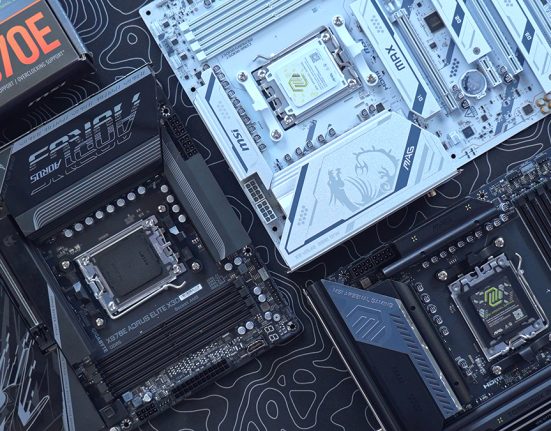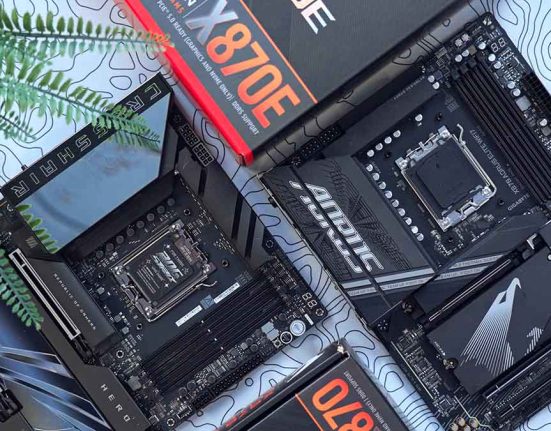Those in the market for a no-compromises OLED gaming monitor should look no further than the Gigabyte AORUS CO49DQ. The Gigabyte AORUS CO49DQ negates the need for multiple monitors on one desk, freeing up space while offering an extremely high resolution and excellent colour accuracy, catering to content creators and gamers alike. To see if this gigantic monitor is worth picking up as a standalone display, we’ve tested the AORUS CO49DQ, analysing its performance, clarity, and colour accuracy ratings.
The AORUS CO49DQ has entered a highly competitive market, with brands like Samsung, Acer, and ASUS providing solid alternative super-ultrawide monitors that are also worth considering. But despite the tough competition, the Gigabyte AORUS CO49DQ looks to stand out as the go-to option for enthusiasts by providing unmatched visual clarity at a more affordable price point compared to existing options.
In this review, we’ve examined the Gigabyte AORUS CO49DQ gaming monitor in-depth, examining its specs, design qualities, features, and use case to determine its value.


Buy the Gigabyte AORUS CO49DQ on:
Specification
The Gigabyte AORUS CO49DQ is a 49-inch display with a max resolution of 5120 x 1440. This monitor is equivalent to two 16:9 27-inch displays, making it very easy to split the AORUS CO49DQ into different quadrants for varying tasks and applications. The panel of the AORUS CO49DQ has a refresh rate of 144Hz and a response time of 0.03ms GtG (grey-to-grey). The response time is particularly impressive, as the grey-to-grey measurement is highly accurate and is the closest representation of hardware-level response times.
The AORUS CO49DQ offers a peak brightness of 1000 nits, which is pretty solid, considering OLED displays don’t have a dedicated backlight. The rated contrast ratio of 1.5 million to 1 is also a desirable quality, as images that are supposed to be black or dark are more lifelike instead of being washed out. The QD-OLED panel that the AORUS CO49DQ uses further enhances visuals, making viewing angles near-perfect, which is much easier on the eyes thanks to the soft 1800R curve of the display.
| Key Specs | Gigabyte AORUS CO49DQ |
|---|---|
| Screen Size | 49″ |
| Max Resolution | 5120 x 1440 |
| Refresh Rate | 144Hz |
| Response Time | 0.03ms GtG |
| Colour Gamut | 99% DCI-P3 |
| Peak Brightness | 1000 nits |
| Contrast Ratio | 1500000:1 |
| Panel Type | QD-OLED |
| Display Inputs | 2 x HDMI 2.1 1 x Displayport 1.4 |
| Additional IO | 1 x USB Type-C (Alt mode: Up to 18W PD) 2 x USB 3.0 Downstream 1 x USB 3.0 Upstream 1 x Earphone Jack |
| VRR Technology | AMD FreeSync Premium Pro |
The AORUS CO49DQ has three display inputs, two HDMI 2.1 ports, and a Displayport 1.4 port on the IO front. The Gigabyte AORUS CO49DQ offers a solid set of four USB ports. The USB Type-C port has an alt mode that delivers up to 18W of power, which is perfect for charging devices. Alongside these are three additional USB 3.0 ports, two of which can be used to charge devices or as inputs for a PC, while the upstream port needs to be plugged into your system.
This monitor also comes with AMD FreeSync Premium Pro as its VRR technology, which provides an excellent display experience when playing HDR content. It is a shame that the AORUS CO49DQ doesn’t offer G-Sync or Adaptive Sync, which can provide better visuals on other graphics cards. However, FreeSync is GPU-agnostic, so even those with Intel and NVIDIA graphics cards can use this technology.
Suggested Article: ASUS ROG STRIX XG27ACS Gaming Monitor Review
Gigabyte AORUS CO49DQ Design
Like other Gigabyte AORUS monitors we’ve tested, the CO49DQ has a black finish across the entire display. It also has relatively thin bezels on the sides and top of the display, with the bottom bezel supporting the monitor panel. It would be nicer to see smaller bezels around the whole chassis, but considering this is a 49-inch monitor, you’re not exactly losing out on any significant screen real estate.

On the aesthetic front, I must admit that the AORUS CO49DQ isn’t the most exciting-looking monitor. The glossy black colouring on the plastic casing around the monitor helps it blend in well with a darker setup. Still, there’s nothing particularly astounding about the look of this monitor. While many will prefer Gigabyte’s minimalist approach, the lack of fancy design qualities will be a point of contention for some.

The AORUS CO49DQ chassis is primarily plastic, with the only metal parts of this monitor being the stand and a small strip underneath the IO. Despite the plastic chassis looking a bit cheaper, it feels rigid and robust and has effectively no flex when pushed or squeezed.

Because this monitor is so huge, the stand needs to be strong enough to hold up the weight of the display. Fortunately, the stand of the AORUS CO49DQ is relatively wide and holds the monitor firmly in place.
The stand offers a small cut-out in the centre for cable management, allowing you to thread through mouse and keyboard wires easily. I think the stand could look nicer. While the neutral black blends in well with the colouring of the display chassis, some RGB or additional colour would add some much-needed flair. However, I can understand the minimalist appeal, which seems to be the central theme of this monitor.

The AORUS CO49DQ also has a fair amount of adjustment, providing several ways to achieve the perfect viewing angle. This monitor has 20 degrees of upward tilt and 30 degrees of swivel. There’s also 130mm of height adjustment, which is helpful for those with extra displays.

It is worth noting that the stand is optional. The AORUS CO49DQ features a 100*100mm mounting space for those who prefer a VESA wall or arm mount. This opens up more room for those trying to maintain a clean desk setup.

Underneath the AORUS logo, you’ll find the OSD joystick, which has an LED to show that your fingers are in the right place. The joystick has four directions of movement and features a firm tactile click that brings up a more extensive menu and additional settings.

Features We Like
Before we examine the image quality and colour accuracy, it’s worth delving into the main features of the Gigabyte AORUS CO49DQ. Below, we’ve highlighted the main features we like and don’t like.
KVM Modes
One of the most unique features of this display is that it comes with a built-in KVM mode, which provides a PIP (Picture-in-Picture) or PBP (Picture-by-Picture) configuration for those with multiple PC setups. This is particularly useful for streaming and content creation, as dedicated resources can be separated for different applications and relayed through one monitor. Because of the resolution, you can leverage two 27-inch monitor screens on one display, which leaves ample room for two separate windows.

During our testing, we found that the KVM mode provided effectively no input lag, and both gameplay screens ran seamlessly. It’s standard for KVM switches to cause extra latency when used, but we enjoyed the blazing-fast 0.03ms response time with no problems.
While including the PBP and PIP modes is incredibly useful, I feel their use case is more niche. When you’ve got multiple machines, using the KVM will be the go-to choice for most users. However, from a productivity standpoint, I found that Microsoft Windows 11 provides much more versatility in terms of creating multiple windows for applications.
Those with Windows 11 will want to use the desktop switcher and window assigner, as the operating system will equally split up and resize the windows you choose. This is an excellent alternative to having multiple monitors on a desk.

Easy to Use OSD
The four-way OSD joystick is used to configure and change the additional settings of the AORUS CO49DQ. This monitor has the basic settings you expect to see with most displays, such as changing inputs, brightness, and contrast. However, Gigabyte has gone a step further with the AORUS CO49DQ, offering OLED Care, a gaming dashboard, a built-in crosshair, KVM switching, FreeSync Premium Pro, and much more. These settings are easily accessible and can be changed quickly by using the joystick and then navigating to the desired settings.

The OLED Care is particularly worth highlighting as it features a range of ways to protect the screen from prolonged usage and burn-in. Pixel Clean, for example, initiates a process that refreshes pixel compensation, reducing the risk of dead pixels and burn-in. I’m a big fan of this feature, and it’s good to see that Gigabyte caters to those who will be using this monitor for long periods.

Incredibly Vibrant
Despite only being a 1440p monitor, the Gigabyte AORUS CO49DQ is exceptionally vibrant. This QD-OLED panel provides rich hues and deep blacks, contributing to a comfortable and enjoyable viewing experience. The AORUS CO49DQ is one of the most visually capable monitors we’ve tested and is well worth considering if you’re a regular consumer of HDR content.

Features We Don’t Like
Restrictive Experience in Games
One of the big issues with ultrawides, especially displays over 40-inches, is that they tend to be harder to work with in games. If a super-ultrawide is your only monitor, tabbing out and resizing a window can be problematic.
Furthermore, the super-ultrawide format isn’t natively supported in all of the latest games. While many AAA titles support 21:9, the 32:9 aspect ratio often requires mods or only has limited support, resulting in black bars in certain parts of the game or within cutscenes. We ran a couple of titles to see how the AORUS CO49DQ performs in games and recorded our experience.
In Destiny 2 (which is a first-person shooter), the screen felt quite stretched. Certain guns didn’t look like they were supposed to, splaying out on the screen more than they usually would. The screen’s wideness made me feel dizzy, which I don’t typically experience on non-ultrawide displays.
One of the more considerable limitations is that I couldn’t tab out of the game without the whole window closing. Destiny 2 often requires a second screen because it allows you to move guns back and forth or easily engage in build crafting, which is much more restrictive on one monitor. And because we’re playing on an ultrawide, there’s no way to easily resize the window, effectively forcing me to play in fullscreen.
In Civilization V, however, this game was meant to be played on an ultrawide. The AORUS CO49DQ showed how great it is for games that benefit from wider FOV (field of vision). It was easy for me to navigate the whole window, and the screen didn’t feel stretched.
Ultimately, picking up an ultrawide for gaming may or may not be worth it, depending on the kind of games you play. Those sticking to games that are natively supported will benefit greatly from a larger screen, as the increased FOV can provide an in-game advantage. However, if you’re the kind of gamer who needs to tab out or plays a lot of FPS titles, it might be worth reconsidering picking up a super-ultrawide.
Gigabyte Control Center Software
While the Control Center software is slightly helpful for changing some of the monitor settings on the fly, the Gigabyte suite isn’t the best component configurator we’ve used. This application gives very few instructions on how to use it, and the settings you can change are pretty limited.
For the AORUS CO49DQ, Gigabyte Control Center software has four tabs that lead to different customisation options. The “General”, “Display”, and “Gaming Assistant” tabs offer some control, while “APP Info” is entirely unexplained. Overall, I feel like Gigabyte Control Center needs more refinement and a general makeover that would make it much more intuitive to use.
Mostly Plastic
For a display around $1200, we were expecting a more luxurious design. The AORUS CO49DQ is mainly plastic, resulting in a cheaper look and feel. Using more premium materials would make the AORUS CO49DQ stand out more than the competition. A monitor like the ROG Swift PG49WCD is a prime example of an ultrawide with excellent visual performance and looks great.

Colour Accuracy & Image Quality
After testing the Gigabyte AORUS CO49DQ for a few days, it is clear that this monitor offers incredible visual fidelity, cementing itself as one of the best super-ultrawide displays for HDR content. However, one of the critical characteristics of this display is its capability in the productivity space, offering solid colour accuracy and standout image quality for video editing and photo editing.
To determine if this monitor is accurate, we tested it by running a colour calibration benchmark with the Datacolor Spyder X Pro. This allows us to analyse the colour coverage across a range of different colour gamuts to see if the performance detailed on Gigabyte’s website is accurate to our results.

After running the Datacolor application, it was no surprise that the AORUS CO49DQ offered 100% coverage of the sRGB colour gamut. Our DCI-P3 results sat just below the rated coverage of 99% on Gigabyte’s website, with a 97% rating, according to Datacolor. Our 97% result is pretty close to Gigabyte’s 99% rating, so we can attribute this 2% to testing conditions or margin of error. Either way, the Gigabyte AORUS CO49DQ’s colour accuracy is impressive, making it a great option for those focusing on content creation workloads.

Conclusion
Gigabyte AORUS CO49DQ

Product Name: AORUS CO49DQ
Brand: Gigabyte
-
Features
-
Design
-
Performance
-
Value For Money
Summary
The Gigabyte AORUS CO49DQ is one of the most vibrant, colour-accurate monitors we’ve tested. Its QD-OLED panel offers bright whites and deep blacks, creating a pleasant and lifelike visual experience. Additionally, the AORUS CO49DQ has handy productivity features, such as the KVM switcher, allowing prospective buyers to control multiple machines through one display. Furthermore, the AORUS CO49DQ is one of the more affordable super-ultrawide displays, undercutting most current market options by about $300-$500, which is impressive considering what’s on offer.
My only major qualm is that this monitor feels very cheap compared to other super-ultrawides we’ve tested. The plastic shell and lack of premium materials anywhere other than the stand make this monitor look and feel much more inexpensive. I understand this may have been an attempt to make the AORUS CO49DQ more affordable; we’d expect a nicer design on a monitor priced at $1200. If you’re in the market for a super-ultrawide, the AORUS CO49DQ is what we’d recommend based on its excellent price point compared to the rest of the market. But keep in mind that while this form factor is great for productivity, it can be more restrictive in games, resulting in more teething and troubleshooting issues than multi-monitor setups.
Pros
✅ Perfect for productivity
✅ Rich colour-accurate panel
✅ Competitively priced
Cons
❌ Restrictive experience in games
❌ Cheap design
❌ Gigabyte Control Center



![FI_[DM86] Montech King 45 Pro + RX 9070](https://geekawhat.com/wp-content/uploads/2026/01/FI_DM86-Montech-King-45-Pro-RX-9070-551x431.jpg)

![FI_[DM82] TT MineCUBE Build](https://geekawhat.com/wp-content/uploads/2025/12/FI_DM82-TT-MineCUBE-Build-551x431.jpg)

![MPI_[DP055] SAMA V60 + 9070 Build Montage](https://geekawhat.com/wp-content/uploads/2025/12/FI_DP055-SAMA-V60-9070-551x431.jpg)
